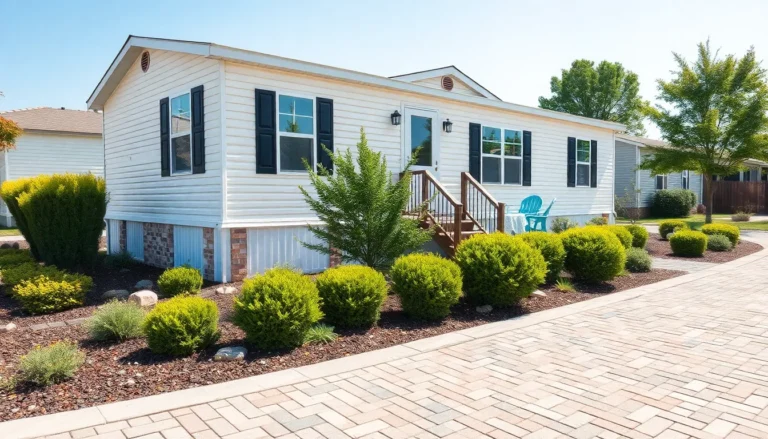Table of Contents
ToggleTransforming a yard from drab to fab doesn’t take a miracle; it just takes a little creativity and some solid landscaping tips. Whether it’s sprucing up a small balcony or tackling an expansive lawn, a well-thought-out plan can turn any outdoor space into a personal paradise. After all, who wouldn’t want to sip their morning coffee surrounded by vibrant blooms instead of a patch of weeds?
Essential Landscaping Tips for Beginners
Successful landscaping relies on thoughtful planning and a solid understanding of the unique attributes of your property. Better design leads to greater enjoyment.
Understanding Your Space
Familiarity with the size and shape of your yard significantly influences design choices. Factors such as sunlight exposure and soil type play crucial roles. For example, a sunny space accommodates a wider variety of plants. Observing existing trees and shrubs also aids in identifying natural focal points. Knowing the layout helps in planning pathways, flower beds, and seating areas. Consideration of drainage patterns ensures water flows efficiently, preventing future issues. These elements combined create a foundation for a balanced landscape.
Choosing the Right Plants
Selecting plants requires consideration of climate, soil conditions, and maintenance levels. Native plants often thrive better than exotic varieties due to their adaptability. Annuals offer vibrant colors throughout the growing season, while perennials provide lasting beauty year after year. Grouping plants by height, color, and texture can enhance visual appeal. Matching plant choices with the sun and shade conditions of your yard also maximizes growth potential. Always consult local resources for guidance on suitable plant selections and potential pests.
Design Principles for Effective Landscaping

Effective landscaping relies on incorporating key design principles that enhance visual appeal and functionality. Understanding elements like color theory and balance significantly impacts outdoor spaces.
Color Theory in Landscaping
Color affects mood and perception in landscaping. Warm colors, such as reds and yellows, create a vibrant atmosphere, ideal for spaces meant for entertainment. Cool colors, like blues and purples, promote calmness, suitable for relaxation areas. Combining contrasting colors heightens visual interest, while analogous colors provide harmony. Using seasonal plants extends the color palette throughout the year, ensuring ongoing visual dynamics. Incorporating hardy, native plants also enhances color presence with minimal maintenance.
Creating Balance and Symmetry
Balance and symmetry are crucial aspects of effective landscaping. Achieving balance involves distributing visual weight evenly across the landscape. Formal gardens often exhibit symmetry, with mirrored plant arrangements and features. Asymmetrical designs, on the other hand, offer a more relaxed feel while still maintaining equilibrium through strategic placement. Pathways and focal points can enhance balance, guiding the viewer’s eye through the space. Incorporating structures like benches or sculptures can further establish focal points, enhancing overall aesthetic appeal.
Practical Landscaping Tips for Maintenance
Maintaining a beautiful landscape requires ongoing effort and attention. Regular care keeps plants healthy and lawns vibrant.
Seasonal Care for Plants
Proper seasonal care ensures plants thrive year-round. Watering frequency should adjust based on season, with early morning being ideal. Fertilization schedules vary; apply spring fertilizers to energize growth. Prune perennials after blooming for robust future blooms. Monitoring for pests is crucial as they can damage plants quickly. Mulching helps retain moisture and suppress weeds during warmer months. Each season brings unique challenges, so staying proactive contributes to a lush landscape.
Lawn Care Tips
Effective lawn care promotes a lush, green lawn. Mowing height significantly impacts grass health; keeping blades longer encourages root growth. Aeration alleviates compacted soil, enhancing water penetration. Fertilize every 6 to 8 weeks during the growing season for optimal grass vigor. Regularly check for weeds, removing them promptly to prevent spread. Irrigation should focus on deep, infrequent watering rather than shallow daily drenching. Following these practices cultivates a healthier, more resilient lawn.
Sustainable Landscaping Practices
Sustainable landscaping practices focus on eco-friendly strategies that enhance outdoor spaces. These methods promote environmental health while improving the aesthetic appeal of gardens and yards.
Water Conservation Techniques
Implementing water conservation techniques is crucial for maintaining a sustainable landscape. Digging rain gardens captures excess rainwater and allows it to filter into the ground. Using drip irrigation systems delivers water directly to plant roots, reducing waste. Selecting drought-tolerant plants ensures the landscape thrives with minimal watering. Mulching retains moisture in the soil, minimizing evaporation. Grouping plants with similar watering needs can further streamline irrigation efforts.
Native Plant Selection
Choosing native plants significantly boosts sustainability efforts. Native plant species adapt well to local climates and require less maintenance compared to non-native varieties. These plants provide habitats for local wildlife, promoting biodiversity. Incorporating a variety of native flowers, grasses, and shrubs improves the landscape’s resilience to pests and diseases. Utilizing local flora minimizes the need for chemical fertilizers and pesticides, leading to healthier ecosystems overall.
Transforming an outdoor space into a personal oasis requires thoughtful planning and creativity. By understanding the unique characteristics of a property and applying effective landscaping strategies, anyone can create a vibrant and inviting environment.
Incorporating sustainable practices not only enhances beauty but also promotes environmental health. Regular maintenance ensures that plants thrive and landscapes remain visually appealing year-round.
With the right approach and dedication, it’s possible to cultivate a stunning landscape that reflects individual style while supporting local ecosystems. Embracing these landscaping tips will lead to a flourishing outdoor sanctuary that everyone can enjoy.




